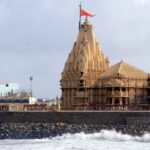In the mystical realm of Hinduism, the 12 Jyotirlinga Temples hold profound significance as sacred abodes of Lord Shiva, the destroyer and regenerator of the universe. Each of these temples is believed to radiate a divine light, symbolizing the infinite nature of Lord Shiva’s cosmic power. Embarking on a pilgrimage to these sacred sites is not just a physical journey but a spiritual odyssey, promising tranquility and bliss to the devoted souls.
Somnath Jyotirlinga
Situated on the western coast of Gujarat, the Somnath Temple is the first among the 12 Jyotirlinga. Known as the “Lord of the Moon,” the significance of Somnath lies in its eternal glory and resilience, having withstood the test of time and historical turmoils.
Mallikarjuna Jyotirlinga
Perched on the Shri Shaila Mountain in Andhra Pradesh, the Mallikarjuna Jyotirlinga Temple symbolizes the union of Lord Shiva and Goddess Parvati. The divine energy that resonates in this sacred space is said to bring harmony and balance to the lives of devotees.
Mahakaleshwar Jyotirlinga
Nestled on the banks of the Shipra River in Ujjain, Madhya Pradesh, the Mahakaleshwar Temple is renowned for its lingam, believed to be swayambhu (self-manifested). This Jyotirlinga represents the timeless aspect of Lord Shiva, as the eternal timekeeper.
Omkareshwar Jyotirlinga
Located on the Mandhata Island in the Narmada River, the Omkareshwar Temple in Madhya Pradesh is a visual marvel. The island’s shape, resembling the symbol ‘Om,’ adds to the spiritual significance, creating an atmosphere of divine resonance.
Kedarnath Jyotirlinga
Perched amidst the lofty Himalayas in Uttarakhand, the Kedarnath Temple is an epitome of natural grandeur and spiritual serenity. Devotees embark on a challenging journey to seek the blessings of Lord Shiva in this tranquil abode.
Bhimashankar Jyotirlinga
Nestled in the Sahyadri Range of Maharashtra, the Bhimashankar Temple is not just a site of religious significance but also an ecological hotspot. Devotees find solace in the serene surroundings as they connect with Lord Shiva, the embodiment of compassion.
Kashi Vishwanath Jyotirlinga
Situated on the banks of the sacred Ganges in Varanasi, the Kashi Vishwanath Temple is a beacon of spiritual enlightenment. The city itself is believed to be a manifestation of Lord Shiva’s cosmic power, offering devotees a direct connection to the divine.
Trimbakeshwar Jyotirlinga
Nestled in the picturesque town of Trimbak in Maharashtra, this Jyotirlinga holds a unique significance. It is believed that the sacred Godavari River originates from the Trimbakeshwar Temple, adding to its spiritual sanctity.
Vaidyanath Jyotirlinga
Also known as Vaijnath, the Vaidyanath Temple in Deoghar, Jharkhand, is associated with Lord Shiva as the ultimate healer. Devotees seek divine intervention for physical and mental well-being in this sacred abode.
Nageshwar Jyotirlinga:
Located on the Dwarka coast in Gujarat, the Nageshwar Temple is believed to be one of the Dwadasha Jyotirlingas. The significance lies in Lord Shiva’s manifestation as the Lord of Serpents, symbolizing control over primal energies.
Rameshwar Jyotirlinga
Situated on the island of Rameswaram in Tamil Nadu, the Ramanathaswamy Temple is a revered pilgrimage site. The purity of devotion is echoed in the rituals performed by devotees who believe that a pilgrimage here washes away sins.
Grishneshwar Jyotirlinga
Nestled near Ellora in Maharashtra, the Grishneshwar Temple completes the list of the 12 Jyotirlingas. It symbolizes Lord Shiva’s boundless compassion, inviting devotees to experience divine love and grace.
12 Jyotirlinga
Embarking on a journey to the 12 Jyotirlinga Temples is more than a physical expedition—it’s a spiritual sojourn. Each temple echoes the timeless wisdom and cosmic energy of Lord Shiva, offering devotees a path to tranquility, bliss, and spiritual awakening. In the embrace of these sacred shrines, seekers find solace, enlightenment, and a connection to the eternal divinity that resides within.







